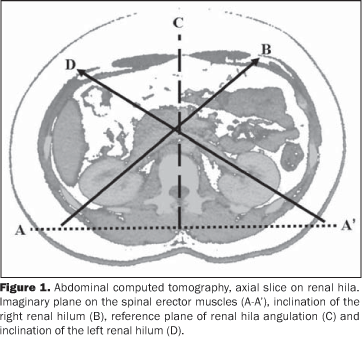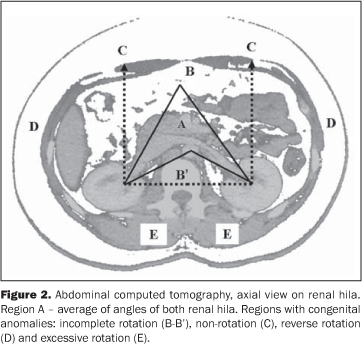Radiologia Brasileira - Publicação Científica Oficial do Colégio Brasileiro de Radiologia
AMB - Associação Médica Brasileira CNA - Comissão Nacional de Acreditação
 Vol. 42 nº 1 - Jan. /Feb. of 2009
Vol. 42 nº 1 - Jan. /Feb. of 2009
|
ORIGINAL ARTICLE
|
|
Normal abdominal computed tomography: a retrospective study of renal hila angles |
|
|
Autho(rs): Makoto Sakate, Alzira Teruio Yida Sakate, Seizo Yamashita, Altamir dos Santos Teixeira, Luciano Barbosa, Luis Antonio Correia |
|
|
Keywords: Congenital anomalies, Renal pelvis, Urinary tract, Helical computed tomography |
|
|
Abstract:
IPhDs, Assistant Professors at Faculdade de Medicina de Botucatu - Universidade Estadual Paulista "Júlio de Mesquita Filho" (Unesp), Botucatu, SP, Brazil
INTRODUCTION Diagnostic imaging specialists have a qualitative view on the normal positioning of renal hila at abdominal computed tomography (CT); however, the authors have not found in the literature quantitative parameters for defining such positioning as related to vascularization (inferior vena cava and abdominal aorta) in a healthy patient. Quantitative (angular) parameters of normal renal hila are necessary for a better definition of congenital abnormalities, especially regarding rotation of renal hila. Rotational anomalies are classified into non-rotation, incomplete, reverse and excessive rotation. Non-rotation (renal hilum turned anteriorly) and incomplete rotation (renal hilum between the anterior and medial regions) are most frequently found. Reverse and excessive rotations are rarely found(1). Late in the embryonic phase, the renal hila are anteriorly positioned and, in the early fetal phase, during the ascent of the kidneys to its normal bed, they rotate medially with their respective hila, lying in an intermediate position between medial and anterior(2). However, angular values or anatomical parameters are not available for defining the normal positioning of renal hila. In the search for a better definition of anomalies of renal hila rotation, the present study is aimed at evaluating individuals with normal abdomens for obtaining quantitative values of mean angulation values for renal hila in relation to the horizontal plane traced over the right and left spinal erector muscles, considering the center of the lumbar vertebral spine as a parameter for measurement of renal hila angles.
MATERIALS AND METHODS The present study evaluated retrospectively 250 abdominal CT studies with oral and intravenous contrast enhancement of both male (128) and female (122) healthy individuals in the age range between 17 and 93 years (mean 52.45 ± 17.42 years) for men, and 21 and 94 years (mean 54.34 ± 18.27 years) for women. All of the patients included in this study presented with normal renal function, with no renal or adjacent disorders, corresponding to a total of 500 renal hila (250 right and 250 left renal hila) evaluated. On magnified abdominal CT cross-sectional views demonstrating renal hila, two lines were drawn: one horizontal line over the right and left spinal erector muscles, and another, perpendicular to the horizontal plane, passing on the middle of the lumbar vertebral body. This horizontal line was considered as the zero degree (0°) angle, and the perpendicular line as an angular reference parameter. The renal hila angulation was calculated from the center of the lumbar vertebra, so the angle calculation for each renal hilum in relation to the horizontal plane has ever taken acute angles into consideration (Figure 1).
The research project was approved by the Committee for Ethics in Research of the Institution, and a term of free and informed consent was signed by the individuals included in the present study. The t-Student test was utilized for comparison of average ages. Averages were obtained, and a 95% confidence interval was constructed for the average of right and left renal hila angles(3).
RESULTS Comparative study between sexes showed that there was no statistically significant difference (p = 0.40376) related to renal hila acute angles. Statistical analysis of 500 renal hila angles calculated from the center of the lumbar vertebra on the horizontal plane determined on the right and left spinal erector muscles demonstrated the following results: mean 42.47° and ± 16.64 standard-deviation for right renal hila angle, and mean 41.57° and ± 13.29° standard deviation for left renal hila angle. The confidence interval of 95% demonstrated limits of 40.40° and 44.54° for mean angle of the right renal hila, and 39.91° and 43.23° for mean angle of left renal hila, that is to say that every interval has a 95% probability of including the average for the study population (Figure 2).
DISCUSSION According to the literature, the kidneys positioning and anatomic orientation do not present any rotational variation with aging for both male and female individuals(4). The upper urinary tract anatomy is demonstrated by CT slices of total or upper abdomen. On the unenhanced phase, the renal contour and the calyceal system appear well-defined at CT images because of the peri- and pararenal fat and the renal sinuses(5,6). After intravenous iodinated contrast agent bolus injection, enhancement of the kidneys is observed during the nephrographic phase, and subsequently the renal hila can be bilaterally identified between the anterior and medial regions(7). Computed tomography allows a noticeable topographic definition of the renal vessels (artery and vein), renal parenchyma and renal hila(8). Three or four minutes following intravenous contrast injection, the renal parenchyma becomes homogeneous and the pyelocalyceal system is filled with contrast, corresponding to the pyolographic phase(9,10). The pyelographic phase allows a spatial visualization and topographic determination of normal renal hila, as well as renal abnormalities in relation to anatomic structures. Congenital renal malformations may present as abnormalities of surface, volume, number, fusion, migration with or without fusion, and rotation. Rotational abnormalities have been identified at CT by the direction of the opening of the divergent renal hilum in the medial region, without utilizing any quantitative parameter for inferring a degree or anatomic structure for reference(11). Most frequently, rotational anomalies are associated with renal ectopia although this phenomenon may occur on its normal bed. The four types of anomalies described are the following: non-rotation, incomplete rotation, reverse rotation and excessive rotation; among them, non-rotation (renal pelvis turned towards the ventral region) and incomplete rotation (renal hilum between the anterior and medial regions of the abdomen) are most frequently found(1,12). Reverse and excessive rotations are rarely found. In reverse rotation, the renal vessels are observed anteriorly to the kidney, and in excessive rotation, posteriorly. These anomalies are responsible for mistakes in the interpretation of excretory urography studies where an organ may be confused with an abnormal mass and inadvertently being surgically removed(2,13,14). However, with the introduction of computed tomography, these anomalies have become more perceptible, allowing the visualization and characterization of rotational details. The most significant aspect to be taken into consideration in cases of malpositioned kidneys, frequently associated with rotational anomalies, is the higher predisposition to excretory pathway obstruction. Obstruction generally occurs in the uretero-pyelic junction with dilatation of the renal pelvis (hydronephrosis) as a result from the compression by aberrant vessels or by the abnormal position of the hilum itself, predisposing to complications caused by dilatation and urinary stasis(14). The present study has allowed the quantification of renal hila positioning in normal abdomens in terms of mean angular values. This interval is within the classification of congenital abnormality corresponding to incomplete rotation, although not occupying the whole angular range for the mentioned anomaly (Figure 2). Higher angular values suggest non-rotation, incomplete rotation or reverse rotation, and lower angular values, hyper-rotation (or excessive rotation). Upon the above considerations, a new definition of rotation anomalies in terms of angular values is necessary for patients submitted to abdominal CT, with changes in the parameters reported in the literature.
CONCLUSION The evaluation of angular rotation of right and left renal hila in relation to a horizontal plane over the spinal erector muscles, with the center of the vertebral body as an angular reference in patients with no evidence of renal or adjacent abnormalities has demonstrated two significant findings: firstly, in the confidence interval of 95%, the average between the right and left hila angles is within the classification of congenital abnormality corresponding to incomplete rotation; and secondly, this abnormality should be divided into normal and abnormality of incomplete rotation.
REFERENCES 1. Emmet JL, Witten DM. Embryology of the genitourinary tract. In: Emmet JL, Witten DM, editors. Clinical urography. An atlas and textbook of roentgenologic diagnosis. 3rd ed. Philadelphia: WB Saunders; 1971. p. 1313-48. [ ] 2. Netter FH. Apparent "ascent and rotation" of the kidneys in embryologic development. In: Netter FH, Shapter RK, Yonkman FF, editors. The Netter collection of medical illustrations - Kidneys, ureters and urinary bladder. 2nd ed. Vol. 6. Rochester: Ciba; 1975. p. 35. [ ] 3. Zar JH. Biostatistical analysis. New Jersey: Pren-tice-Hall; 1996. [ ] 4. Meschan I, Parker MD. Urinary tract. In: Meschan I, editor. Roentgen signs in diagnostic imaging. Abdomen. 2nd ed. Philadelphia: WB Saunders; 1986. p. 145-316. [ ] 5. Parienty RA, Pradel J. Radiological evaluation of the peri- and pararenal spaces by computed tomography. Crit Rev Diagn Imaging. 1983;20:1-26. [ ] 6. Prassopoulos P, Cavouras D. Renal parenchymal thickness in children measured by computed tomography. Eur Urol. 1994;25:51-4. [ ] 7. Emmet JL, Witten DM. The normal urogram. In: Emmet JL, Witten DM, editors. Clinical urography. An atlas and textbook of roentgenologic diagnosis. 3rd ed. Philadelphia: WB Saunders; 1971. p. 267-339. [ ] 8. Dalla Palma L, Rossi M. Advances in radiological anatomy of the kidney. Br J Radiol. 1982;55: 404-12. [ ] 9. Dalla Palma L, Bazzocchi M, Cressa C, et al. Radiological anatomy of the kidney revisited. Br J Radiol. 1990;63:680-90. [ ] 10. Yokoyama M, Watanabe K, Inatsuki S, et al. Measurement of renal parenchymal volume using computed tomography. J Comput Assist Tomogr. 1982;6:975-7. [ ] 11. Yokoyama M, Watanabe K, Inatsuki S, et al. Computerized tomography of the kidney: tissue-plasma ratio of contrast enhancement with bolus injection and renal function. J Urol. 1982;127: 721-3. [ ] 12. Netter FH. Anomalies in rotations. In: Netter FH, Shapter RK, Yonkman FF, editors. The Netter collection of medical illustrations - Kidneys, ureters and urinary bladder. 2nd ed. Vol. 6. Rochester: Ciba; 1975. p. 230. [ ] 13. Emmet JL, Witten DM. Anomalies of the genitourinary tract. In: Emmet JL, Witten DM, editors. Clinical urography. An atlas and textbook of roentgenologic diagnosis. 3rd ed. Philadelphia: WB Saunders; 1971. p. 1349-603. [ ] 14. Swischuk LE. Anomalies of the upper urinary tract. In: Swischuk LE, editor. Imaging of the newborn, infant, and young child. 3rd ed. Baltimore: Williams & Wilkins; 1989. p. 593-6. [ ] Received May 8, 2008. * Study developed at Faculdade de Medicina de Botucatu - Universidade Estadual Paulista "Júlio de Mesquita Filho" (Unesp), Botucatu, SP, Brazil. |
|
Av. Paulista, 37 - 7° andar - Conj. 71 - CEP 01311-902 - São Paulo - SP - Brazil - Phone: (11) 3372-4544 - Fax: (11) 3372-4554


